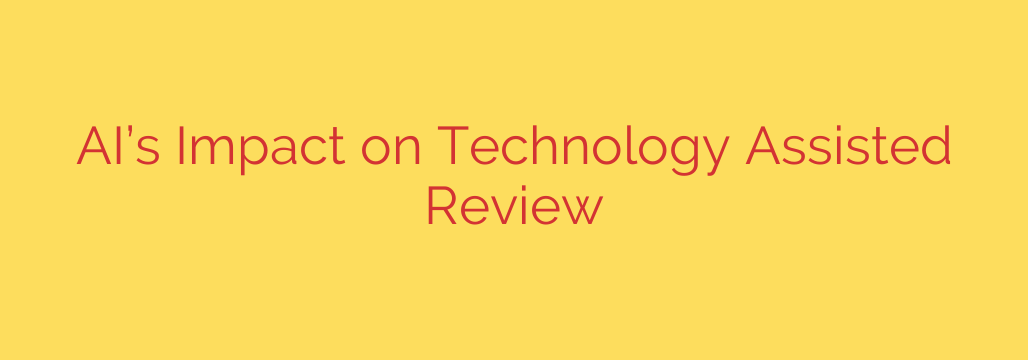
The New Era of eDiscovery: How AI is Revolutionizing Technology Assisted Review
In the world of litigation and corporate investigations, the sheer volume of digital data can be overwhelming. Sifting through millions of documents, emails, and messages to find relevant evidence is a monumental task. For years, Technology Assisted Review (TAR) has been the go-to solution, using algorithms to separate the relevant from the irrelevant. But now, a new wave of artificial intelligence is transforming this process, making it faster, smarter, and more accurate than ever before.
Understanding the Foundation: What is TAR?
Technology Assisted Review, often called predictive coding, is a process where human legal experts train a software system to identify relevant documents in a large dataset. Attorneys review a small sample of documents, coding them as “relevant” or “not relevant.” The software learns from these decisions and then applies that logic to the entire document population, prioritizing the most likely relevant files for human review.
This has been a game-changer for eDiscovery, but traditional TAR systems have limitations. They often require significant human input upfront and are primarily based on keyword matching and simple statistical patterns. They can struggle with nuance, context, and complex legal concepts.
The AI Evolution: Beyond Predictive Coding
The latest advancements in AI, particularly Large Language Models (LLMs) and Generative AI, are pushing the boundaries of what TAR can accomplish. Unlike older systems that simply match words, modern AI platforms can understand the conceptual meaning and context behind the text.
This leap forward means AI can now perform tasks that were once the exclusive domain of human reviewers:
- Conceptual Understanding: AI can identify key concepts, themes, and arguments within a document, even if specific keywords are not present.
- Summarization: It can generate concise summaries of long and complex documents, allowing legal teams to grasp the core information in seconds.
- Advanced Classification: AI can categorize documents based on complex criteria, such as identifying privileged information, trade secrets, or specific contractual clauses, with minimal initial training.
Key Benefits of Integrating Advanced AI into Document Review
The shift towards AI-powered TAR is not just an incremental improvement; it’s a paradigm shift that offers tangible advantages for legal professionals.
1. Unprecedented Speed and Efficiency
The most immediate benefit is a dramatic increase in review speed. AI can analyze millions of documents in a fraction of the time it would take a human team. This accelerates the entire eDiscovery timeline, allowing legal teams to build their case strategy faster and meet tight deadlines with greater confidence.
2. Enhanced Accuracy and Consistency
Human reviewers, no matter how skilled, are prone to fatigue and inconsistency. An AI model applies the same logic to every single document, drastically reducing the risk of human error. By identifying patterns and connections that a person might miss, AI can achieve a higher level of accuracy in flagging relevant information.
3. Deeper Insights and Strategic Advantage
Modern AI doesn’t just find documents; it uncovers insights. It can perform sentiment analysis to gauge the tone of communications, identify key actors in a conversation through entity recognition, and group documents by topic. This provides legal teams with a holistic understanding of the dataset, enabling them to spot trends and formulate stronger legal arguments.
4. Significant Cost Reduction
By automating the most time-consuming aspects of document review, AI-powered TAR delivers substantial cost savings. Fewer billable hours are spent on manual review, which directly translates to lower eDiscovery costs for clients and more predictable budgets for law firms.
Navigating the Challenges: Security and Defensibility
While the benefits are clear, adopting advanced AI in legal review requires careful consideration of the risks. Two major concerns stand out: data privacy and defensibility.
- Data Privacy: eDiscovery datasets often contain highly sensitive information, including personally identifiable information (PII) and privileged communications. It is crucial to ensure that any AI platform used has robust security protocols, including data encryption and strict access controls.
- Defensibility: Legal teams must be able to defend their review process in court. This means the AI’s decision-making process cannot be a complete “black box.” Reputable AI tools provide transparency and validation workflows, allowing attorneys to test the model’s accuracy and document the process to ensure it is defensible.
Actionable Tips for Implementing AI in Your Legal Practice
To harness the power of AI responsibly, legal teams should follow a set of best practices:
Prioritize a Human-in-the-Loop Approach: AI is an incredibly powerful tool, but it is not a replacement for legal expertise. The most effective strategy combines AI’s processing power with the critical thinking and oversight of experienced attorneys. Final decisions must always rest with human experts.
Thoroughly Vet Your Technology Vendor: Not all AI tools are created equal. Partner with vendors who prioritize data security, offer transparent validation processes, and have a proven track record in the legal industry. Ask about their data handling policies and security certifications.
Establish Clear and Defensible Protocols: Before beginning a review, establish a clear protocol for how the AI will be used, tested, and validated. This includes sampling the AI’s results to confirm accuracy and documenting every step of the process to ensure it can withstand judicial scrutiny.
The integration of advanced AI is reshaping the landscape of Technology Assisted Review. By moving beyond simple keyword matching to a deeper, conceptual understanding of data, these tools empower legal teams to work faster, more accurately, and more strategically than ever before. For firms that embrace this change responsibly, the future of eDiscovery is not just more efficient—it’s more intelligent.
Source: https://collabnix.com/how-ai-is-driving-advances-in-technology-assisted-review/








